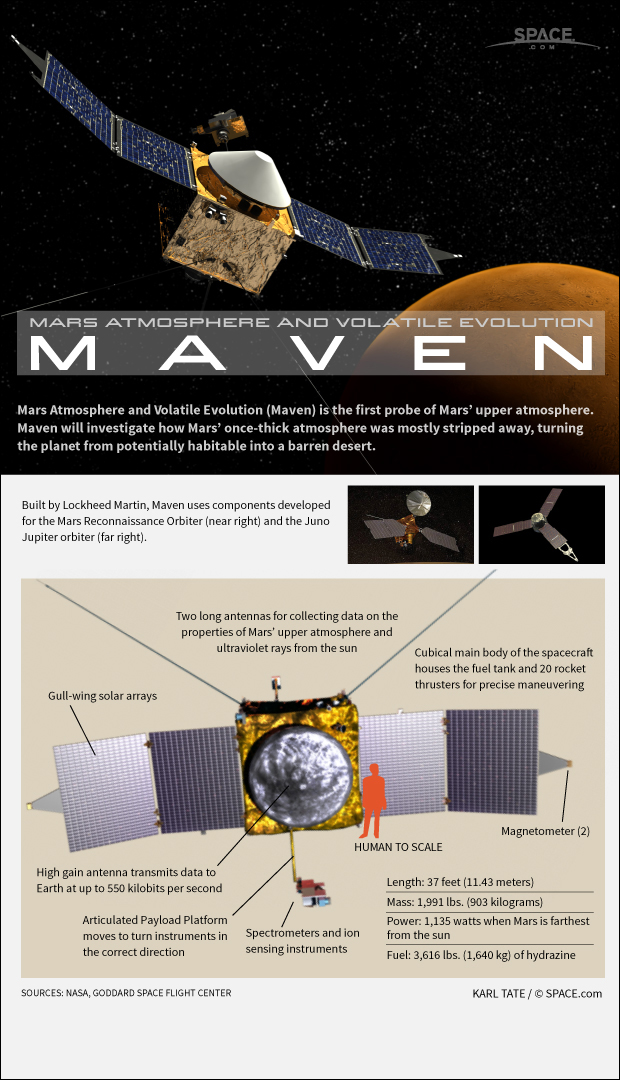How NASA's MAVEN Mars Orbiter Works (Infographic)

Update for Nov. 16: The unmanned Atlas 5 rocket that will launch NASA's MAVEN spacecraft toward Mars on Monday, Nov. 18 at 1:28 p.m. EST (1828 GMT) has rolled out to its launch pad at the Cape Canaveral Air Force Station in Florida. You can watch MAVEN's launch on SPACE.com, courtesy of NASA TV.
Latest Stories
This Rocket Is Going to Mars with NASA's MAVEN Probe (Photos)
NASA's MAVEN Mars Probe: 10 Surprising Facts
NASA's Mars Atmosphere and Volatile Evolution (MAVEN) is the first probe of Mars' upper atmosphere. Maven will investigate how Mars' once-thick atmosphere was mostly stripped away, turning the planet from potentially habitable into a barren desert.
Built by Lockheed Martin, the MAVEN spacecraft uses components developed for the Mars Reconnaissance Orbiter and the Juno Jupiter orbiter.
Photos: NASA's MAVEN Mission to Mars
The cubical main body of the spacecraft houses 3,616 pounds (903 kilograms) of hydrazine fuel and 20 rocket thrusters for precise maneuvering. Two long antennas attached to the man structure are used for collecting data on the properties of Mars' upper atmosphere and ultraviolet rays from the sun.
Videos:
- Why Is Mars A Desert Wasteland? NASA MAVEN Mission Will Investigate | Video
- Why Keep Sending Probes To Mars? NASA GSFC Chief Scientist Explains | Video
- MAVEN Timelapse: Ready For Mars In Mere Minutes | Video
- LeVar Burton On MAVEN: Star Trek Star Explains New Mars Mission | Video
The main high gain antenna transmits data to Earth at up to 550 kilobits per second. Twin solar panels provide 1,135 watts of electrical power when Mars is farthest from the sun.
An articulated boom carrying spectrometers and other instruments pivots to point sensors in the correct direction.
- NASA's Maven Mission to Mars: Photos
- Where Did Mars' Atmosphere Go? NASA to Investigate | Video
- MAVEN Mars Mission: Latest News, Photos and Video
For the latest information on MAVEN, visit:
Follow us @Spacedotcom, Facebook and Google+.
Join our Space Forums to keep talking space on the latest missions, night sky and more! And if you have a news tip, correction or comment, let us know at: community@space.com.
Get the Space.com Newsletter
Breaking space news, the latest updates on rocket launches, skywatching events and more!

Karl's association with Space.com goes back to 2000, when he was hired to produce interactive Flash graphics. From 2010 to 2016, Karl worked as an infographics specialist across all editorial properties of Purch (formerly known as TechMediaNetwork). Before joining Space.com, Karl spent 11 years at the New York headquarters of The Associated Press, creating news graphics for use around the world in newspapers and on the web. He has a degree in graphic design from Louisiana State University and now works as a freelance graphic designer in New York City.
